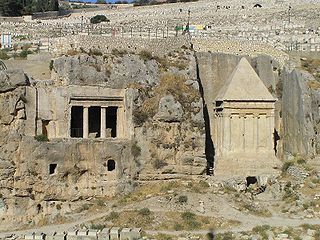 W
WAkeldama is the Aramaic name for a place in Jerusalem associated with Judas Iscariot, one of the original twelve apostles of Jesus.
 W
WThe Cave of the Minor Sanhedrin is a burial cave located next to the Tomb of Simeon the Just in the Sheikh Jarrah neighborhood of Jerusalem. It contains 26 burial niches, in which the 26 members of the Minor Sanhedrin are said to be buried. There are also other burial caves in the complex.
 W
WJason's Tomb is a rock-cut tomb dating to the first century BCE in the Hasmonean period, discovered in the Rehavia neighborhood in Jerusalem, Israel. It has been identified as the burial site of a certain Jason, possibly a naval commander, based on the charcoal drawing of two warships discovered in the cave.
 W
WA list of the monuments and the memorials at the Mount Herzl national cemetery and the Yad Vashem Holocaust memorial in Jerusalem.
 W
WMamilla Cemetery is a historic Muslim cemetery located in Israel just to the north-west of the walls of the Old City of Jerusalem, near Herod's Gate. The cemetery, at the center of which lies the Mamilla Pool, contains the remains of figures from the early Islamic period, several Sufi shrines and Mamluk-era tombs. The cemetery grounds also contain the bodies of thousands of Christians killed in the pre-Islamic era, as well as several tombs from the time of the Crusades.
 W
WMount Herzl, also Har ha-Zikaron, is the site of Israel's national cemetery and other memorial and educational facilities, found on the west side of Jerusalem beside the Jerusalem Forest.
 W
WThe Mount of Olives or Mount Olivet is a mountain ridge east of and adjacent to Jerusalem's Old City. It is named for the olive groves that once covered its slopes. The southern part of the Mount was the Silwan necropolis, attributed to the ancient Judean kingdom. The mount has been used as a Jewish cemetery for over 3,000 years and holds approximately 150,000 graves, making it central in the tradition of Jewish cemeteries. Several key events in the life of Jesus, as related in the Gospels, took place on the Mount of Olives, and in the Acts of the Apostles it is described as the place from which Jesus ascended to heaven. Because of its association with both Jesus and Mary, the mount has been a site of Christian worship since ancient times and is today a major site of pilgrimage for Catholics, the Eastern Orthodox, and Protestants.
 W
WRock-cut tombs are a form of burial and interment chamber used in ancient Israel. Cut into the landscapes surrounding ancient Judean cities, their design ranges from single chambered, with simple square or rectangular layouts, to multi-chambered with more complex designs. Almost all burial chambers contain a platform for primary burial and an ossuary or other receptacle for secondary burial. There is debate on if these tombs were originally intended for secondary burials, or if that practice arose later. The use of rock-cut cave tombs in the region began in the early Canaanite period, from 3100–2900 BCE. The custom lapsed a millennium, however, before reemerging in the earliest Israelite tombs, dating to the 9th century BCE in Jerusalem. The use of rock-cut tombs reached its peak in the 7th and 8th centuries BCE, before rapidly declining and eventually falling out of use in the 6th century BCE in some regions. Use of the tombs has been recorded as recently as the Late Roman Period around the 3rd century CE. The use of such tombs was generally reserved for the middle- and upper-classes, and each typically belonged to a single nuclear or extended family.
 W
WTombs of the Sanhedrin, also Tombs of the Judges, is an underground complex of 63 rock-cut tombs located in a public park in the northern Jerusalem neighborhood of Sanhedria. Built in the 1st century CE, the tombs are noted for their elaborate design and symmetry. They have been a site for Jewish pilgrimage since the medieval period. The popular name of the complex, which has the most magnificently carved pediment of ancient Jerusalem, is due to the fact that the number of burial niches it contains is somewhat close to that of the members of the ancient Jewish supreme court, the Great Sanhedrin, namely 71.
 W
WThe Victims of Acts of Terror Memorial in Israel is a monument to civilian Jewish and non-Jewish victims of terrorism in modern Israel and the pre-state Land of Israel, from 1851 to the present. The memorial was established in 1998 in the National Civil Cemetery of the State of Israel on Mount Herzl, Jerusalem. At the same time, Yom Hazikaron, Israel's Remembrance Day, was officially renamed the Remembrance Day for Fallen Soldiers and Victims of Terror.